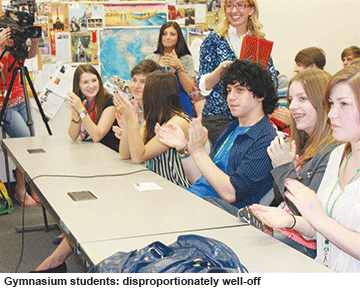Germany: School system row
GERMANY, AUSTRIA AND German-speaking Switzerland have an education tradition that sets them apart from most other countries.
Children tend to get out of school at mid-day instead of late afternoon. Secondary schools are divided into three types. The basic one prepares for technical apprenticeships and vocational training. The middle one teaches skills such as book-keeping. And the highest, called Gymnasium (to evoke ancient Greece, not athletic facilities), leads to university.
For a country that sees itself as egalitarian, this smacks of class privilege — those going to Gymnasiums tend to be disproportionately well-off. But the system also deserves credit for producing highly qualified manufacturing workers, and Germans have long approved of the arrangement.
 Then came the PISA (Programme for International Student Assessment) shock of 2001. International comparisons of 15-year-old pupils in reading, science and maths conducted by the OECD club of rich countries found German pupils merely mediocre. With education exclusively overseen by the federal republic’s 16 states, the PISA rankings also found big internal differences: pupils in Bremen and Berlin fared badly, whereas those in Saxony and Bavaria did well.
Then came the PISA (Programme for International Student Assessment) shock of 2001. International comparisons of 15-year-old pupils in reading, science and maths conducted by the OECD club of rich countries found German pupils merely mediocre. With education exclusively overseen by the federal republic’s 16 states, the PISA rankings also found big internal differences: pupils in Bremen and Berlin fared badly, whereas those in Saxony and Bavaria did well.
The PISA shock launched a frenzy of reform. Some states tried to fix everything at once. All-day schools have become more common, with one in three German pupils now attending them. So have comprehensive schools, which combine the three types and are loved by the left. Tests and syllabuses have changed. And more parents want children to get into Gymnasiums. There are now twice as many students at university as in vocational training. Private schools, rare in Germany until the 1990s, are growing fast.
Perhaps as a result, German pupils have improved in recent PISA tests. Yet far from being happier, parents in western states are livid. Their fury is aimed at one particular change: the move, a decade ago, in most states from nine-year Gymnasium programmes (for a total of 13 school years) to an eight-year one. The justification was to align German pupils, who used to enter the workforce older than their peers, with the international norm of 12 school years. But the implementation was rushed, with the same material stuffed into less time. Parents complain that children are stressed, that they have to drop afternoon activities and that they are cramming for exams without learning deeply.
But Wolfgang Nowak, who was Saxony’s education secretary in the years after reunification and designed its school system, says that going back to G9 is “insanity and nonsense”, because it romanticises childhood. “There are better debates to have, such as how to offer more preschools or to find and promote the best teachers,” he contends.
(Excerpted and adapted from )















Add comment